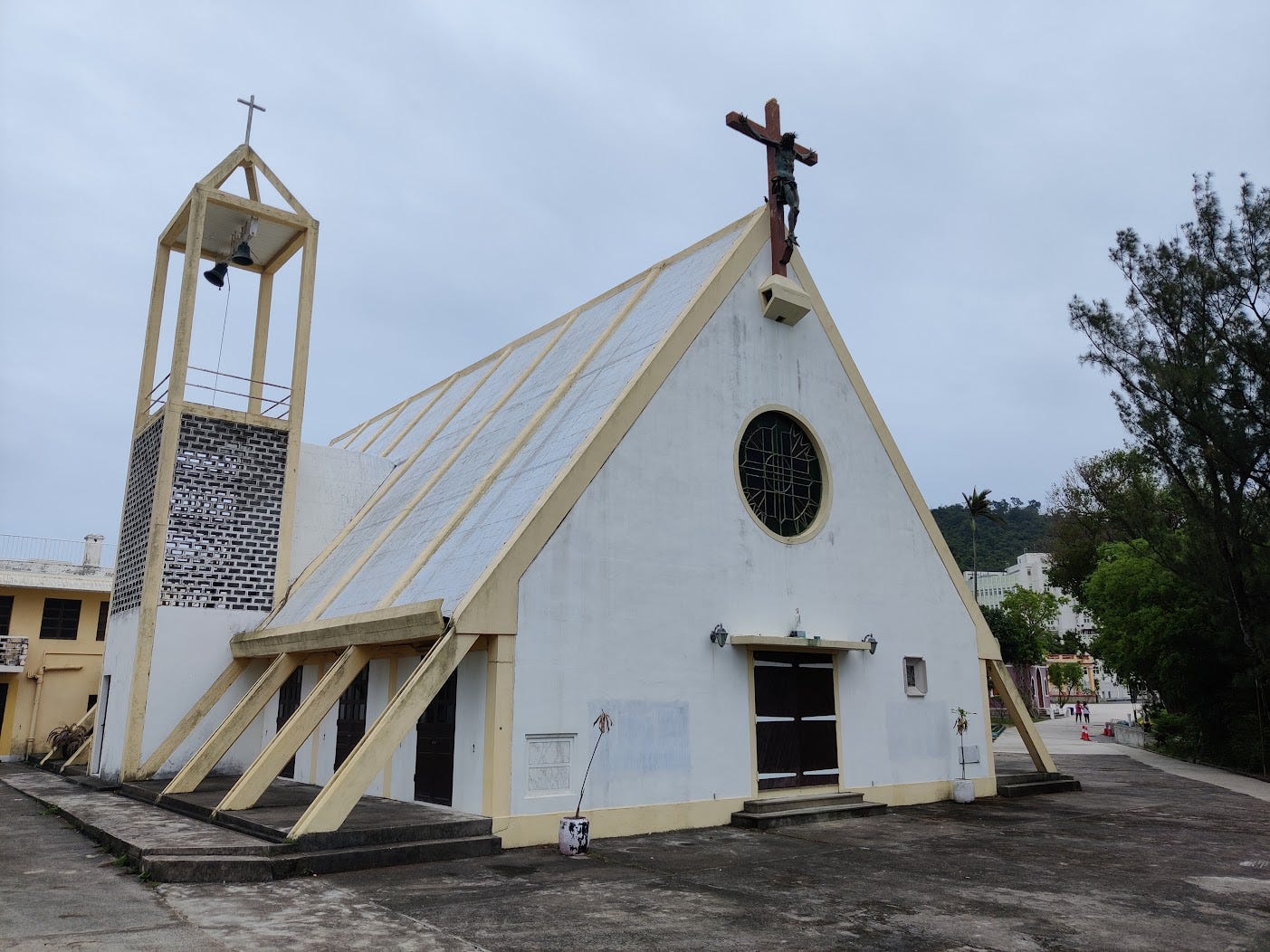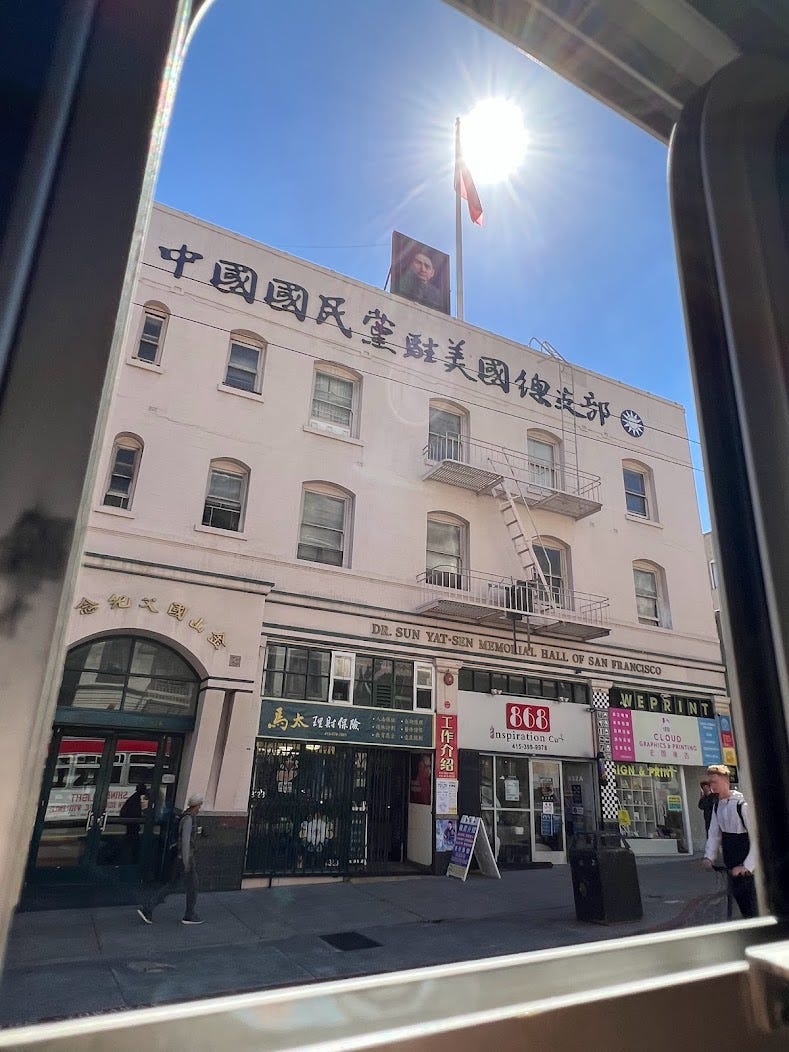I’ve been living in San Francisco since June. On my commute from the Marina to the Financial District, my bus drives through Chinatown. There’s a building on Stockton St with a Republic of China banner on top, alongside a portrait of Sun Yat-sen, the Chinese parens patriae; this is the US headquarters of the Kuomintang, or the Chinese Nationalist Party.
At the beginning of the 20th century, Sun built a network of revolutionaries in places like Tokyo, Hong Kong, Hawaii, and California — under his leadership, the Kuomintang (KMT) led the Xinhai Revolution in 1911, ending China’s last feudal dynasty. Two world wars later, the Kuomintang lost the Chinese Civil War to the Communists. The KMT outlived the Chinese Republic: Chiang Kai-shek, went into exile in Taiwan, where the authoritarian Chinese nationalist remained president of the Republic of China. It also outlived Sun, who passed away in 1925.
The KMT government declared martial law in Taiwan as it struggled to reconquer mainland China, which was trapped in its own political turmoils; democratic reforms in Taiwan didn’t happen until the 1980s. Lee Teng-hui — who was born on the island under Japanese colonialism — received an invitation from his alma mater Cornell University to visit the US in 1995. Beijing protested the visit by conducting missile tests around the Taiwan Strait, triggering the Third Taiwan Strait Crisis.
Lee, who had been appointed as president in 1990, won Taiwan’s first direct presidential election in 1996 despite cross-strait tensions. Four years later, KMT supporters accused Lee of nominating Lien Chan — instead of the more popular James Soong — ending 55 years of KMT one-party rule in Taiwan and handing the presidency to the Taiwanese nationalist Chen Shui-bian from the Democratic Progressive Party.
I wasn’t around to witness any of this in newspapers or on TV. I didn’t learn it from textbooks, either, for what it’s worth — the history of the KMT in Taiwan was too politically sensitive to be taught in Chinese schools, and here in America it feels too irrelevant to be covered in any AP US History crash course. I’ve always been curious why history books aren’t written in reverse chronological order: as a kid I never cared for Neanderthals, or how Yu the Great controlled the floods. I’ve always wanted to know why things are the way they are today — so a curious mind digs into the history of yesterday, and the day before that. The puzzles are already there.
A few months ago I ran into Eric Chu — who currently chairs the KMT in Taiwan — on Stanford campus. He was visiting the Hoover Institution, and as he was getting out of the car outside the Hoover Tower we nodded politely to each other, or at least I thought so. I wonder what it feels like to be a public figure in your own part of the world, and then when you travel abroad you’d assume no one knows who you are — but there I was, a stranger by the sidewalk, having watched his 2016 presidential election debates against Tsai Ing-wen and James Soong.
In both the US and China, where I went to school, it’s taken for granted that one learns about their own history in the classroom. When I went to Macau, a former Portuguese colony handed over to China in 1999, I realized that there were few history books about the city. Most local high schools adopt history textbooks that are also used in other parts of China, but they don’t talk about local history at all other than passing reference to Macau’s handover. In the words of Macau academic Chin-Pang Lei, the city is “invisible”: Macau’s identity and history have been overshadowed by more dominant Sinophone cultures.1 To outsiders — and perhaps to natives as well — its history merely exists in relation to the Chinese imagination as a laboratory for China’s neoliberal transition.

I eventually stumbled upon Camões C. K. Tam’s 1994 dissertation, Disputes Concerning Macau’s Sovereignty between China and Portugal (1553-1993). The book was written with a grant from the KMT and published in Taiwan. Tam was born and raised in Macau but moved to Taiwan for university; this was common practice for students from Macau since the city didn’t have very good higher education institutions.2 Tam later became a pundit — till this day he’s anti-CCP but pro-China, an old-school KMT fellow traveler who still refers to the Chinese government as communist bandits. In Tam’s book he walks the political fine line — clarifying at every possible occasion that when he talks about the Chinese government, he isn’t giving legitimacy to the Communists. The book was in Chinese and out of print, and I managed to get a Xerox’ed copy of it from, funnily enough, the National Library of China in Beijing — I don’t have the copy with me anymore, but I remember there’s a stamp somewhere stating that the book is for reference only, and the sovereignty claims shouldn’t be recognized.
I digress.
On my way to work yesterday, I decided to Google kuomintang headquarters sf. The website looks like it was made with Adobe Dreamweaver, but I was relieved to find that its news feed was still up to date. Eric Chu did visit the Chinatown building during his Bay Area visit. I perused the organization’s About Us page:
1905: The Father of Our Nation, Mr. Sun Yat-sen, founded Tongmenghui in Tokyo, Japan.
1908: The Chinese American Li Shi Nan joined Tongmenghui in Hong Kong. Hu Hanmin sent him back to the US to organize Tongmenghui in America.
1909: Li Shi Nan secretly established Tongmenghui in San Francisco Chinatown, registered in the State of California under the name “Young China Association.”
This was followed by a list of similar historical events of the KMT and the Chinese anti-Qing revolution, as well as news about the Kuomintang US Headquarters. There’s a curious omission of the KMT’s defeat and its exile in Taiwan in 1949:
1945/9/9: Triumph in the Sino-Japanese War. The Japanese signed an unconditional surrender to the Republic of China in Nanjing.
1948/5/5: A tomb was built in the suburbs of Guangzhou to commemorate Li Shi Nan, who established Tongmenghui branches in the Americas.
1953: Donated $2,500 to the Sacramento branch of the Sacramento Chinese Association, which advocates for the building of the Sacramento branch.
1954/9/20: Mobilized US KMT branches to host the “All-America Chinese Anti-Communist National Salvation Conference.”
It seems like nothing significant happened between 1957 and 1989, when the headquarters “was registered as a nonprofit corporation under California law to file tax returns for public activities.” Then comes 2000:
2000: In the past four years, there was a person surnamed Lee who, by appearing to be loyal, obtained a big position under false pretenses, deceived and betrayed the Party, and eventually tried to destroy the Party. Although he was later expelled from the Party after the Party spurned him, the Party’s vitality was greatly damaged. In addition to losing the presidential election, the Party also lost the Legislative Yuan. The overseas Chinese community was unsettled by the change in overseas Chinese policy. As an important overseas branch of the Party, we have been trying to save the tide and to stabilize the hearts of the overseas Chinese, and we have learned from our pain and have been working with the central government to register our members. We’re waiting for our time to rise again.
This was referring to Lee Teng-hui, the Cornell graduate who lost the KMT's 55-year streak of colonial authoritarianism. It’s uncanny, now that I think of it, how the KMT is hated by almost everyone, and Sun Yat-sen — the man who started it all — hated by no one. Sun was a political hero for Mao, who dubbed him a bourgeois revolutionary; his portrait briefly stood at Tiananmen Square in 2020, directly facing Mao’s on the watchtower.
Chin-Pang Lei 李展鵬, Yinxing Aomen: bei hushi de chengshi yu wenhua 隱形澳門:被忽視的城市與文化 [Invisible Macau: An Overlooked City and Culture], 1st edition (New Taipei City, Taiwan: Yuanzu wenhua 遠足文化, 2018).
Before the handover to China, it was easy for Macau citizens to obtain a Republic of China passport after graduating from a Taiwanese university and finding a job there.




studying the past has helped me make sense of the present, but I agree with this
"I’ve always been curious why history books aren’t written in reverse chronological order: as a kid I never cared for Neanderthals, or how Yu the Great controlled the floods. I’ve always wanted to know why things are the way they are today — so a curious mind digs into the history of yesterday, and the day before that. The puzzles are already there."